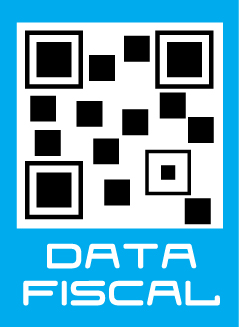| |
INTRODUCTION
MATERIALS PROVIDED BY SINTERMETAL FOR AUTOMOTIVE BEARINGS
IDENTIFICATION OF SINTERMETAL’S CODES 20-327 / 7 F
INTERPRETATION AND USE OF THE CATALOG
CRANKSHAFT IDENTIFICATION
LISTS (YOU MUST HAVE EXCEL)
DOWNLOAD CATALOGS
This Catalogue
was initially thought for the Latin American automobile market, without
specifying parts which are destined to marine engines, compressors, hydraulic
pumps, etc., as generally these parts aren´t selled as spare parts
but only to specific customer for whom we manufacture by request.
By all means, we are in conditions of supplying whichever type of bearings
as of our raw material, made up by imported strip aluminum tin 20% or
cast copper lead, always that requested quantities will justify the manufacture
of needed tools for their manufacture and control.
To face an initial quotation and subsequent manufacture we require your
sending drawings and specifications of material or in last instance, samples
of needed parts.
Important
Note
All information contained in this Catologue was obtained from best possible
reliable sources and in our understanding find them to be correct. We
won´t accept responsabilities for whatever information that has
been published.
This Catalogue is not a Manual containing instructions for its proper
use and for professional installation of bearings, so there fore doesn´t
represents a counsel in the legal sense.
Furthermore it doesn´t replace technical instructions given by engine
manufacturers, which will always have priority, especially ones referred
to tolerancies, as well as recommendations given for installation and
maintenance.
Neither knowledge of specialized people can be left out, as they will
surely have necessary capability and technical formation, to judge in
eachcase on the installing or not of the bearing. Sintermetal is not responsable
for following damages consequene of an incorrect installation.
Will be grateful on receipt of your news regarding whichever error you
may find.
Model´s description or vehicle number mentioned will only be useful
for reference and comparation purposes.
At printing of new catalogues former ones will loose their validity.
Introduction
Sliding Bearings (Precision Products)
Continuous increase in specific performance of gas and diesel
motors, as well as diminution of their size, forced to contantly
improve sliding bearings in form, structure and material, in order
to adjust them to this new demand.
The every time more strict regulations regarding polution and
noise produced by engines, summed to the objective of fuel saving,
obliged to lessen power waste due to friction in the engines,
lead to design bearing for either gas or diesel bearings, so as
to comply with following four main requirements.
1º) Specific high power, or expressed in other words more
power per unit´s cylinder capacity.
2º) Maximum torque, if possible along whole range of rpm
of the engine.
|
|
3º) Great compability with surroundin environment, reducing
noise levels and contamination through
gas escapes.
4º) High volumetric efficiency of the combustion chamber (4
or more valves per cylinder). High rpm rate. Electronic injection
systems both in gas as well as diesel and diminution in weight of
parts in movement. High gas and injection pressures in diesel and
high combustion temperatures are used
to comply above mentioned requirements.
Consequently, this will automatically increase load in each component
part of the engine and particularl the bearings.
All experience abtained up to now and one to be adquired, is passed
to users through SINTERMETAL´s bearing, responding fully to
extreme service conditions with wished confiability.
|
Materials provided by sintermetal for automotive bearings
Our Connecting Rod and Main Bearings are manufactured and used
in motors of internal combustion, produced with a steel back (Fig.
1) and having high modulus elasticity which guarantees reliable
support on its bore, appart from having one or several antifriction
layers, that have the sufficiently necessary high resistance to
fulfill its function, having also good adherence in between them
as well as with the steel back.
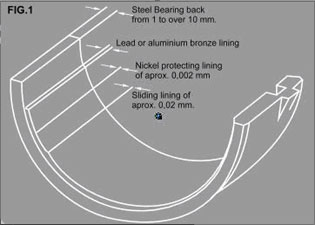
Also, when circumstances will so require and according to Plant´s
drawings, “Anti-whirl” bearings are each time more
frequently used, due to different thickness of the washer than
in zone near the partition line, with the object of securing journal´s
estability and fast forming of lubrication´s hydrodinamic
wedge. (Fig. 2)
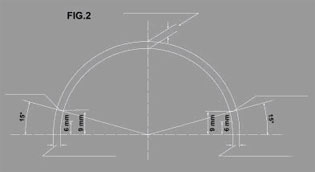
I - Crown Thickness
II - 15º Thickness from the parting line
III - End Thickness from the parting line
|
|
1) Continuous cast copper lead bearings “Sintermetal
F”
The antifriction material, in intermediate layer of the bearing,
is a mix of heterogeneous copper lead, of thin grain and poreless,
where lead, element acting as antifriction, must preferably be located
in friction zone with the journal and far away, if possible, from
steelback, with which it doesn’t adhere, so thus obtained
through continous casting process on steel strip, by the use of
quick cooling speeds scientifically checked to achieve the fixing
of ideal lead structures formed as vertical nedles (dentritics)
instead of nodules, thus proving to our bearing an unequalled fatigue
resistance.
This process, originally patented by an United States firm, demands
as its name indicates, a continous process of manufacture in time,
that´s why Sintermetal SAIC imports this material in the form
of strip. with the cast copper lead of the intermediate layer already
adhered, allowing the manufacture at Argentina of an ideal bearing
for turbocharged diesel engines or normally pretended ones of great
demand.
2) Aluminium -Tin 20% steel backed bearings
In the case of our Aluminium bearings, made through lamination process
with simultaneous thermic treatment in between the different steps,
making tin to be distributed in reticular matrix of aluminium, thus
allowing the obtention of mechanic properties that exceed in 80%
load capacity of babbit, due to its has great fatigue resistance,
so consequently very much used in actual rapid gas and diesel engines.
Finally, the carefull selection of the various materials, the complementing
function of the different layers and thicknesses exactly adapted
in between them, achieved through modern conforming processes, mechanization
and galvanoplasty, with Argentinian manual labor conveniently trained
and supervised, as well as imported strip already mentioned, transform
finished bearings to be in an international level, and suitable
to be installed.
3) Sintered material 80-10-10 (SAE 797) “Sintermetal
SB”
Material used for general construction of bushings, very resistant
to blows and high load capacity. Also used in beam´s bushings,
thrust washers exposed to hig impact, velocity box and piston pin
of gas engines.
4) Cast Material 80-10-10 “Sintermetal FB”
Also as above mentioned, used in bushings construction where load
may reach limit values, as for example, in piston bushings for diesel
turbo engines.
|
Identification of sintermetal’s codes
20-327 / 7 F
TYPE OF PIECE / SET OR COMPONENT / ENGINE / QUANTITY PER SET /
MATERIAL
Type of piece:
1 - Connecting rod bearing.
2 - Main bearing.
3 - Half thruswashers.
4 - Camshaft bearings.
5 - Whole thruswashers.
6 - Piston pin bushings.
7 - Rocker arm bushings.
8 - Armonic shaft bushings.
9 - Sundry bushings.
Set or components: 0 - indicates complete set.Other
number, components of the set.
Motor´s number: It is a Sintermetal’s
Internal number given to each engine.
Quantity per set: Quantity of pairs of bearings
that form a set.
The letter following previous number, indicates alloy, so:
A: Aluminium Tin - 20% (imported strip) S: Sintered copper lead
SB: Sintered material 80-10-10 (SAE 797)
|
|
F: Cast Copper Lead (imported strip) B: Babbit metal FB: Cast material
80-10-10
EXAMPLE: 10-327/6 F
10 - Con rod bearings set
327 - Sintermetal engine number.
/6 - Cuantity of pair by set
F - Material
10 - Con Rod. Bearings set 20 - Main bearing set
30 - Thrust washer set 40 - Camshaft bearings 50 - Flanged bearing
60 - Piston pin bushing. 70 - Rocker arm bushing. 80 - Bushing for
antivibration shafts 90 - Various bushings
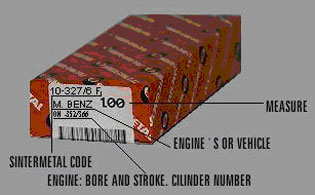
|
Interpretation and use of the catalog
1º)Once identified page where engine figures, by the use
of "Alphabetical order per Marks" . We have the Heading.

|
Column
1: Group to which engine belongs.
Column 2: Number of Cylinder - Bore and Stroke
Column 3: SINTERMETAL set Bearing number
Column 4: Individual bearing number in the bearing
back and
Column 5: Quantity of bearings indicated in pairs
that form the Coluna 10: Vertical oil clearance
set and their position on the crankshaft
Column 6: Standard diameter of shaft in mm and
inches
Column 7: Housing bore diameter
Coluna 8: Widness of the bearing (in case of
flanged main bearings, measure is between outside faces)
Column 9: Wall thickness at its crown or from
thrust washer its position:
X= Both identical bearing; I= Inferior bearing, S= Superior bearing.
|
|
NOTE: In case of flanged bearings:
The Fig. ‚correspond to half bearing.
The letter H correspond to a pair.
Figure © correspond to a bushing.
EQUIVALENCE IN MILIMETERS FOR ORIGINAL CRANKSHAFTS IN INCHES
Taking into account that an undersize of 0.10” in inches is
equivalent to 0,254mm and so on the following undersizes:
|
PULG INCH. |
MM
|
PULG
INCH. |
MM |
| .010” |
0,254 |
.060” |
1,524 |
| .020” |
0,508 |
.070” |
1,778 |
| .030” |
0,762 |
.080” |
2,032 |
| .040” |
1,016 |
.090” |
2,286 |
| .050”
|
1,270 |
.100 |
2,540 |
|
Crankshaft Identification
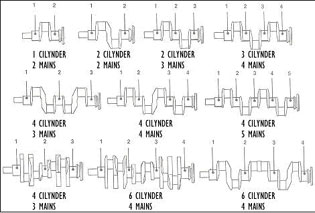
|
|
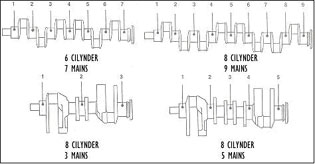
UP |
|
|
